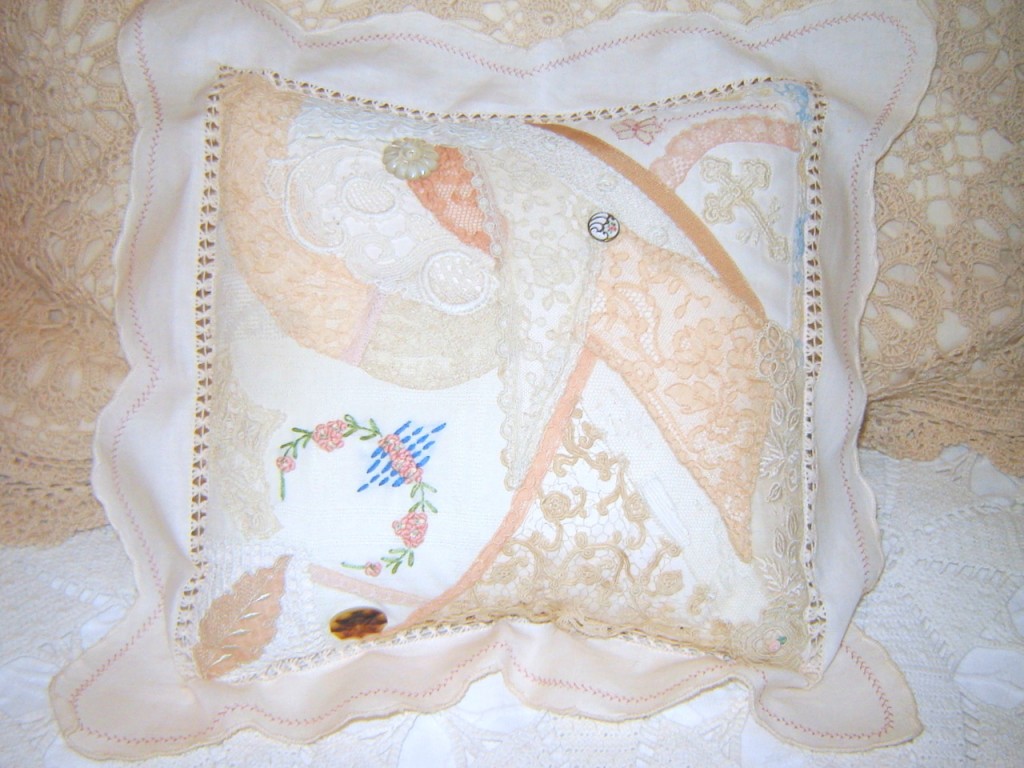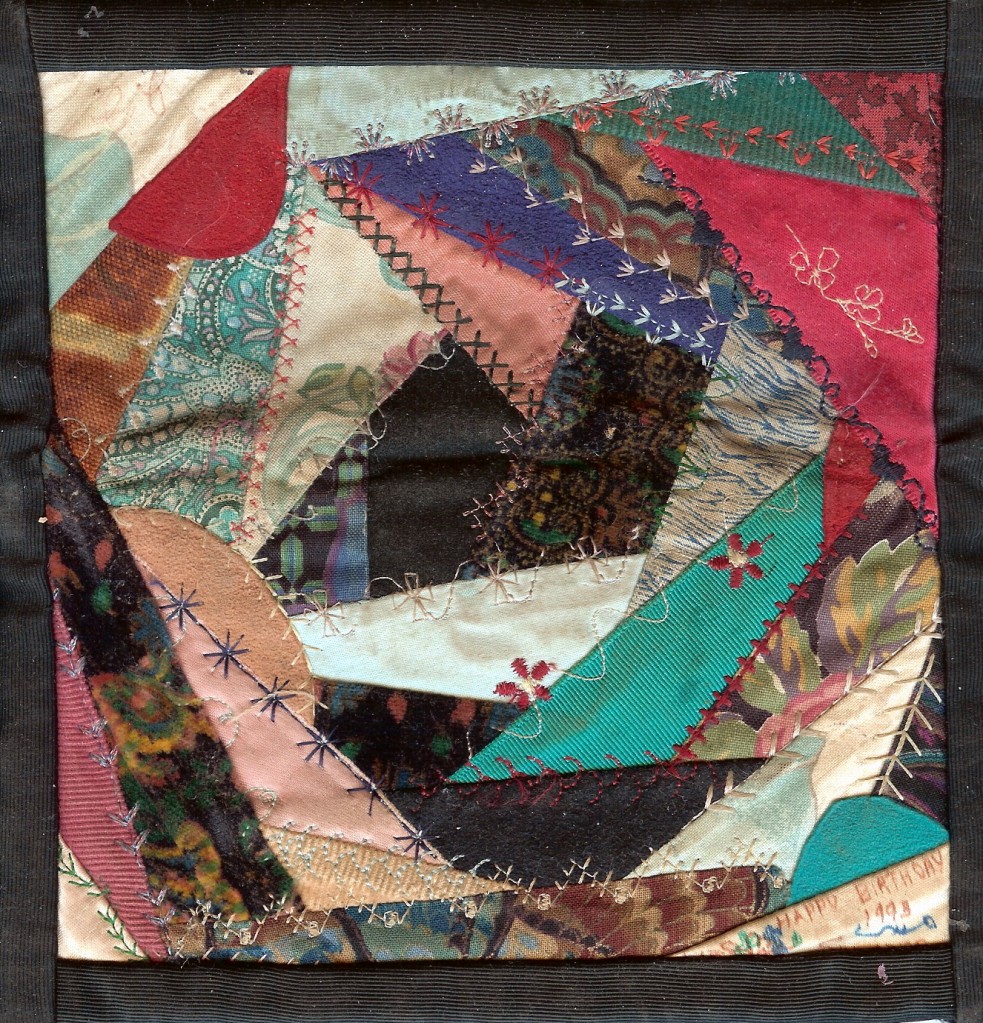In the crazy quilt of life, I’m glad you’re in my block of friends. ~Author Unknown

I love crazy patch. It’s been a while since I’ve done any, since there’s not much call for crazy patch clothing for grandchildren. But I came across this pillow while plundering through Rebecca’s cedar chest and recalled fondly the fun I had stitching it.
Many years ago, my dear friend  Suzanne Sawko and I sat down one day with bags and bags of scraps, two women on a mission to learn crazy patch. We sewed for almost 7 hours and each finished a piece about 8″ square. But we loved it. Later, Suzanne made hers into a checkbook cover for my birthday. I treasure and use it still.
That foray into crazy patch was the beginning of a passion for this form of faux quilting. The rage began in the late 1800’s and was primarily a showcase of luxurious fabrics embellished with fancy handwork stitches. The “quilts, which usually consisted on only a top and a backing, and sometimes not even a backing, served no other purpose than that of a  decorative show off of the stitcher’s skill, taste, fine fabrics and leisurely lifestyle.
As crazy patch rarely has a filler of batting, it doesn’t truly qualify as quilting. I do have a primitive antique crazy patch quilt that is made of wools with batting and was clearly made for warmth. But neither the pillow above or the checkbook cover have all three parts of the traditional quilt sandwich.
The first article I wrote for Creative Needle magazine was the beginning of a series on antique textiles. Rather than re-inventing the wheel, I will simply use that text. Meanwhile, I hope you will take a minute to enlarge the above photo to see the beauty of some of these very old textiles.
From Creative Needle, July/August 1994:
What needleworker can resist fingering a fine, old, tatted doily or hand embroidered tablecloth? These stitched survivors  a time when fine handwork graced every home call to us for intimate inspection. Finding uses for beautifully aged linens is made easy by employing them in the originally intended manner or by following the suggestions in books such as Linens and Lace by Tricia Foley.
Salvaging the damaged survivor of time becomes a stimulus to creativity. Though stained and torn, lying unceremoniously on the ten cents per item table at the church rummage sale, a hemstitched, monogrammed linen pillow case demands restored dignity, as do other wounded textiles rescued from unseemly sites.
Antique lace yardages are a special treasure for the delicate intricacy of the patterns and the unusual styles popular in another era. While today’s laces are primarily white, ecru or champagne, those of yesteryear flaunted their glory in a comparative riot of color, from pastel pinks, blues, peaches and yellows to black, parchment gold, rusty browns, hunter greens and raspberry. Incorporating this unique yardage requires careful inspection of its condition and thoughtful planning for a project which highlights the exceptionality of the piece. This column will explore the use and reuse of these special heirloom textiles, both maiden and timeworn.
Collecting :     As the reader becomes more aware of creative uses for antique textiles, it is easier to be more forgiving when scrutinizing a piece. Instead of rejecting a 14″ length of spectacular lace at an antique show because it seemed too short or too fragile for most garments, consider a non-garment application. When examining damaged, stained dresser scarves and tea towels with charming handwork or exceptional trim, remember that stains and have influenced the affordable price. Can a project be designed around these imperfections? And remember that antique lace on cards is available at some heirloom shops and can be used in combination with special finds to complement and fill in any shortage.
Collectors of vintage textiles are wise to inform others of this interest. Several of this writer’s friends have called when clearing out Grandma’s attic to offer old family laces, linens and fabrics. One friend lovingly rescued a filthy but spectacular antique cutwork blouse from the church rummage, laundered it and presented it as a gift. Another dear friend, with whom some uncommon finds have been shared, returned the favor when her great-uncle sent her all of dear, departed Auntie’s old cards of antique lace.
Using: The antique lace crazy patch pillow not only showcases the timeless beauty of the textiles, but is the result of an exciting design challenge. When the usable portions of scrap lace and damaged linens vary in size, shape and proportion, the crazy patch format is a viable solution. An assortment of antique yardage was assembled, including a wonderful piece of Binche lace sporting tennis players at the net and a length of silk grosgrain ribbon, both purchased at a needlework shop. Also selected was a damaged embroidered linen hand towel, a stained hanky with a fine tatted edge, the corner of a mangled lace tablecloth, carelessly machine washed by an unappreciative heir.
Other additions to the collection include an estate sale find, a delicate taupe silk leaf from a garland of such leaves, wound on a “Made in France” card, complete with the dressmakers calculations for an unspecified garment which was due to be delivered May 5, 1946.
All pieces were stitched with very fine monofilament thread to a purchased pillow top, tea-dyed to a warm peachy pink color. As a finishing touch, the scalloped edge of the flange was embellished with a feather stitch worked in silk thread. There is a great deal of satisfaction to be had from incorporating seemingly unusable vintage handwork in a beautiful heirloom accessory. At the next yard sale or foray into a thrift shop, evaluate the textiles for their existing beauty, not lost perfection. Â


